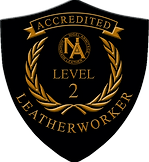
About
Training
The majority of my formal leatherwork training has been with Nigel Armitage at his workshop in England. Nigel is a world-renowned Master Craftsman and leatherwork teacher, and he runs a leatherwork school in England. I initially went to Nigel to refine my hand stitching technique, and I was so impressed by the quality of his teaching that I went back to take his Level 2 leatherworker course. After passing that, I went on to explore belt and bag making in more detail with him. I have also had the opportunity to study traditional briefcase making with Martin Carsewell.


Design and template making
The first stage of any project is producing a design brief. This defines the desired functional and aesthetic elements of the project, as well as the materials to be used. From there, templates are created in card. These allow us to visualise the project in more detail and to see how components will work together. Every part is templated, hardware is located on the templates, and every stitch is marked.

Leather selection
Each hide is carefully inspected for defects before cutting, and thoughtful consideration is given when selecting specific sections for particular components. For example, belly sections are avoided for belts or bag panels due to their stretch and softness.

Cutting and skiving
Careful hand-cutting using specialist knives and well practised precision cutting techniques. This approach ensures absolute control over grain direction, symmetry, and the placement of natural features within the hide.

Saddle stitching
Stitching is done by hand using the traditional saddle-stitch. The process is much slower and requires significantly more skill than machine sewing, but the resulting seam is far stronger.

Edge finishing and polishing
The edge crease: A crease line is applied to the edges by hand using a heated creasing iron. This line frames the piece, giving it a more professional appearance. It also adds protection, as the compressed fibres of the crease help prevent water wicking in from the edges and causing damage.
Once the piece is assembled, any cut edges are hand-sanded and then slicked with a wooden hand slicker. This process can be repeated several times until the desired level of smoothness is achieved. The edges are then sealed and polished.
Finally, the piece is conditioned and buffed by hand.

Visit the workshop
If you would like to visit the workshop to discuss a project or repair please contact me in advance.
phone: 0401 811758
OR
I can often accept visitors at short notice, but I don't have a staffed shop front that can accept drop-ins. I may be away from the workshop or busy with clients.

